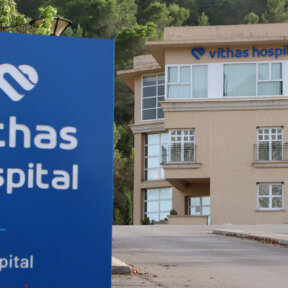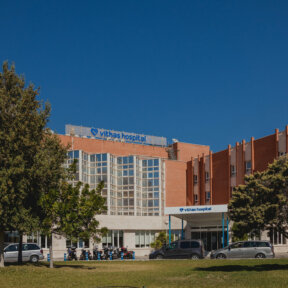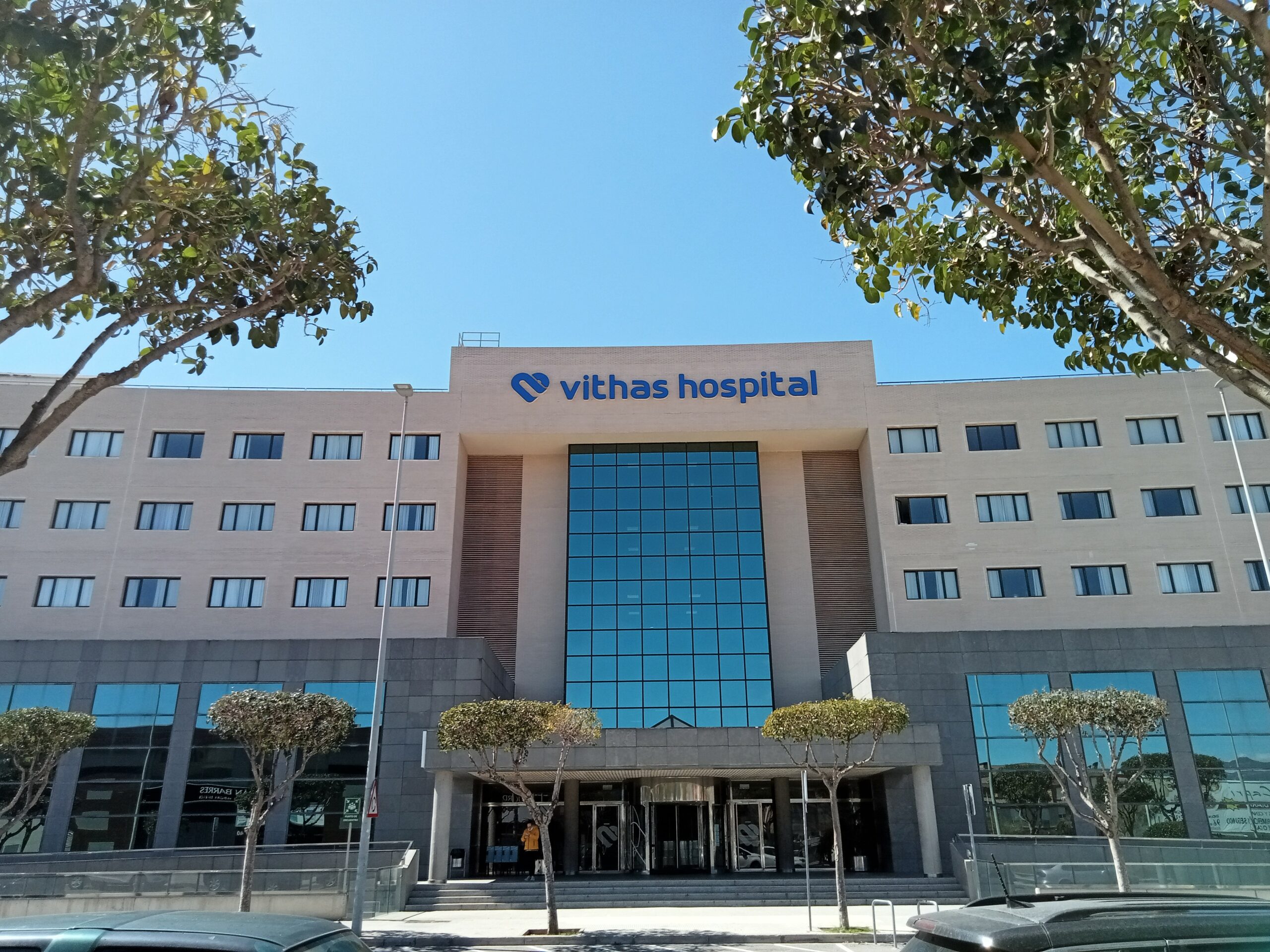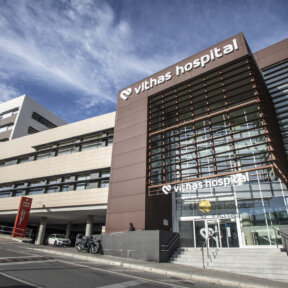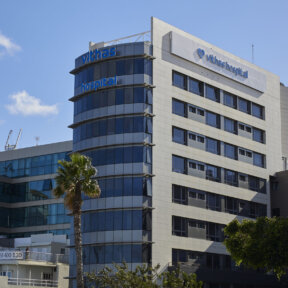What is cardiology?
The speciality of cardiology focuses on the diagnosis of cardiovascular diseases, from the most common conditions (such as ischemic heart disease, arrhythmia, heart failure or valvulopathies) to the prevention of risk factors that can lead to their appearance such as hypertension, hypercholesterolemia or diabetes.
In Vithas centres, these conditions are addressed with prevention, diagnosis (both in the earliest stages and in acute situations) and treatment, offering patients the best technological options currently available.
Cardiovascular mortality remains the leading cause of death in Spain. The aim of cardiologists is to reduce this mortality rate and cardiovascular events in our patients.
Which patients is it for?
Patients at high risk of a cardiovascular event, even if they do not yet have symptoms of a cardiovascular disease, are a central part of our activity, because it is prevention that will have the greatest impact in reducing future cardiovascular problems.
Therefore, patients with cardiovascular risk factors such as hypertension, diabetes, dyslipidemia, obesity, smoking, etc. are assessed in our units.
It is also aimed at patients with symptomatic cardiovascular diseases. This included all patients with a clinical history of ischemic heart disease (angina or infarction), arrhythmias, heart failure in any of its forms of presentation.
The main symptoms for which patients come to our clinic are chest pain, dyspnoea (fatigue), palpitations, syncope or dizziness and oedema.
Main conditions and diseases
The most prevalent cardiovascular diseases are ischemic heart disease (angina or infarction), arrhythmia, especially atrial fibrillation, heart failure and valvulopathies.
However, ischemic heart disease is nothing more than the reflection of a systemic vascular disease that we call arteriosclerosis, which can also affect other vascular territories such as the arteries of the brain (causing stroke) or the legs. As such, our units provide comprehensive, cross-disciplinary treatment in collaboration with other professionals who also treat these conditions, such as neurologists, cardiac and vascular surgeons, endocrinologists, nephrologists, etc.
Although these are the most common diseases, our work also includes managing rarer but high-impact conditions in society such as the prevention of sudden death, family heart disease, cardio-oncology (prevention of myocardial damage from oncological treatment), congenital heart disease and aortic diseases.
- Angina
- Myocardial infarction
- Syncope
- Vascular heart disease
- Heart murmurs
- Congenital heart defects
- Heart failure
- Hypertension
- Arrhythmia
- Prevention of cardiovascular risk
Main diagnostic resources and technology
The cardiologists at the Vithas Group have all the latest and most up-to-date diagnostic and therapeutic resources used in modern cardiology. Thanks to this, an electrocardiogram, echocardiogram, stress test or 24-hour monitoring with a Holter can be performed in the same consultation.
These are the basic diagnostic techniques performed in consultation, which may be completed with more specific non-invasive diagnostic tests available in our units, such as long-term Holter monitoring (7 to 15 days) or implants, ergospirometry, stress or transoesophageal echocardiograms, tilt table test, blood pressure Holter, etc.
However, if more advanced diagnostic imaging tests are required, our centres can conduct CT angiography, cardioresonances or nuclear medicine studies.
If an invasive procedure is needed either for arrhythmia (electrophysiological studies) or haemodynamics (coronary angiography), we have the latest technology in these fields, enabling us to perform any diagnostic tests or therapeutic actions needed.
- Electrocardiogram
- Ergometry/ergogasometry (cardio-pulmonary function test)
- Holter (24-hour electrocardiogram)
- Ambulatory blood pressure measurements (ABPM)
- Tilt bed syncope study
- Real-time colour Doppler 3-dimensional (3D) echocardiography
- Transoesophageal echocardiogram
- Carotid intima study: vascular age
- Exercise and/or pharmacological stress techniques with cardiac imaging to detect myocardial ischemia: with ultrasound, isotopes or magnetic resonance imaging
- Electrophysiological study and radiofrequency ablation
- Electrical cardioversion
- Cardioresonance
- 64-slice cardio CT scan: study of coronary calcium score and coronary arteries Cardiac anatomy and function
- Stress test: Arrhythmic stratification: microvolt T-wave alternans, SDNN, filtered QRS duration, post-potential QRS, QT
Main treatments
In the field of ischemic heart disease, the use of coronary angiography and percutaneous angioplasty with stent implantation is essential. In the field of arrhythmias, all percutaneous ablations are available, as well as the implantation of pacemakers or defibrillators with or without resynchroniser.
In addition, there are new non-surgical treatments available for valvulopathies such as the implantation of percutaneous aortic valves (PAVI) or non-surgical mitral or tricuspid valve repair with the implantation of MitraClips, or the closure of perivalvular leaks and permeable foramen ovale. Cardiac rehabilitation also allows patients who have undergone acute treatment for angina or heart attacks to carry out a multidisciplinary lifestyle modification programme that guarantees a future without new cardiovascular events.
Areas of specialisation
Cardiology is a discipline with a high degree of subspecialisation. The most notable areas are the arrythmia unit and the haemodynamics and catheterisation units.
In some of our larger centres, there are also units specialising in cardiac imaging, heart failure, paediatric cardiology and familial heart disease.
Special services
Many modern cardiology techniques now allow cardiovascular diseases to be treated without surgery and therefore without putting the patient through discomfort or at risk. In the field of arrhythmias, atrial fibrillation ablation due to its high prevalence is a technique we perform in our centres with the highest levels of quality and technology.
In the field of what we call structural cardiology or non-surgical treatment of valvulopathies, the implantation of percutaneous aortic valves without surgery is another technique we offer across our centres.
Why come to our clinic?
The speciality of cardiology has a unique advantage, and this is that most diagnostic and therapeutic tests are performed by cardiologists themselves, so there is no need to request tests from other departments or staff that may delay diagnosis and treatment.
Not only do we have all the means for tests, but they are performed on a one-stop basis, enabling us to conduct most tests patients require in the same consultation. Moreover, our cardiologists work with the HEART TEAM to come up with the best solution for each patient after assessing all the options with the various professionals who will contribute to management and treatment (anaesthesiologists, cardiologists, cardiac surgeons, endocrinologists, neurologists, vascular, etc.)
Myocardial infarction
Thanks to modern cardiology, patients with acute myocardial infarction with high risk of lethality can now be discharged in three or four days, if they come in early to a centre such as ours. Treatment involves the implantation of stents in coronary arteries and a disease management programme that allows patients to return to family or work life as soon as possible with the accompaniment of the cardiology team to improve their lifestyle and prevent a new event in the future.
The ultimate goal is to achieve a higher quality and longer life for patients with cardiovascular disease or at risk of having it.
FAQs
What are murmurs?
A murmur is a “noise” doctors can hear when they listen to the heart with a stethoscope. It is caused by turbulent blood flow as it passes through the heart’s cavities and valves. Murmurs aren’t always a sign of heart disease. A heart murmur is a sound, not a disease. Finding a heart murmur isn’t necessarily cause for alarm, but it should be followed up.
What is a functional murmur?
Functional murmurs, also called innocent or non-pathological murmurs, are harmless murmurs heard in a normal heart. These murmurs are often found in children (most of them tend to disappear when they get older) and also in pregnant women (since pregnancy increases blood volume), although they usually disappear after giving birth.
Pregnancy-associated anaemia can also increase the chance of developing functional murmurs. Other situations that can cause functional murmurs are hyperthyroidism or maintained tachycardia.
What is the relationship between smoking and cardiovascular disease?
About 40,000 people die each year from heart disease caused by tobacco smoke. Smoking is the main cause of atherosclerosis, a disease that occurs when the lining of the arteries deteriorates due to fat deposits, obstructing the flow of blood through them. This results in a reduced supply of oxygen-rich blood to the heart, which can lead to chest pain (angina) or heart attack.
What is heart failure?
This is a problem of increasing magnitude and high economic impact, with survival in advanced grades lower than that of many types of cancer.
It is a chronic and progressive disease caused by the heart’s inability to pump enough blood to meet the body’s oxygen needs.
Therapeutic resources to treat heart failure range from heart transplantation to new and potent drugs that have been shown to improve the quality of life and increase the survival rate of patients with heart failure.
Is moderate alcohol consumption good for the heart?
While for some people, drinking alcohol carries significant risks (patients with heart failure, high blood pressure, diabetes, arrhythmias, etc.), for others, moderate alcohol intake may offer a degree of protection (increased levels of “good” cholesterol; reduced blood pressure; inhibition of blood clot formation).
Moderate means no more than one light drink per day for women or people with lower body weight and no more than two drinks per day for men. However, until we know more about the pros and cons of drinking alcohol, doctors recommend avoiding it for better heart health.
What is aortic stenosis?
Aortic stenosis is the partial obstruction of blood flow through the aortic valve. This condition can be congenital or rheumatic, but the most common cause today is calcified degenerative stenosis, which occurs in elderly people.
In fact, it is currently the leading cause of heart valve surgery in Spain. Senile degenerative aortic stenosis, which is the most common cause of this condition today, is caused by prolonged exposure to stress in the valve and is characterised by calcification of the valve. It is more frequent in diabetics and hypercholesterolemia patients.
What is atrial fibrillation?
Atrial fibrillation is an irregular and often abnormally fast heart rate, although it can also be seen at almost normal heart rates. It is a very common arrhythmia, but can be dangerous if it continues over time and cause chest pain, difficulty breathing, palpitations or dizziness.
The most dangerous risk is blood clots forming inside the atrium, which can come out of the heart and cause a cerebral embolism.
There are different types of treatment to control it, including drugs to control the heart rate or the beginning of the arrhythmia and using anticoagulants to prevent embolisms. There are also invasive procedures such as a catheter ablation that can cure this arrhythmia in certain cases.
What are extrasystoles?
Ventricular or supraventricular extrasystolia is an alteration of the heart rhythm that usually appears in young, healthy people without heart disease. It is caused by a premature heartbeat (extrasystole). It is often related to situations of emotional stress and can be triggered by using substances such as coffee, tea, tobacco and alcohol, so it is recommended to avoid these substances and learn to manage stress.
They are usually identified by an ECG or a 24-hour Holter. Most of the time they are harmless and do not pose a risk to patients. With regard to medication, it is always best to consult a cardiologist to study your particular case and determine the treatment to be followed.
What is Wolff-Parkinson-White syndrome?
Wolff-Parkinson-White syndrome is characterised by an abnormal cardiac conduction system (accessory pathway) and the occurrence of arrhythmias. This abnormality occurs from birth.
Although it is not usually associated with structural heart abnormalities, an echocardiogram is recommended to rule them out (especially hypertrophic cardiomyopathy, coronary sinus abnormalities and Ebstein’s anomaly).
WPW syndrome is diagnosed by very characteristic electrocardiographic abnormalities on the electrocardiogram (short PR, delta wave). Sometimes, these electrocardiographic alterations are permanent and in others transient.
In many cases you can carry this syndrome without ever having tachycardia, and in these cases no specific treatment is necessary. If it comes with symptomatic tachycardias, it can be treated with antiarrhythmic drugs. However, the curative treatment is an electrophysiological study and catheter ablation.
The choice of treatment depends on the severity of the symptoms and the patient’s preferences. Ablation permanently cures the disease and avoids you having to take medication for life. However, as it is an invasive procedure, it is important to discuss possible complications with your doctor, however unlikely these may be. If you have a lot symptoms or high-risk arrhythmias, catheter ablation is always the first option.





